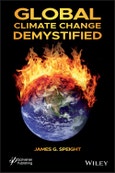Tackling one of the most controversial subjects of our time, one of the world's foremost environmental and petroleum engineers explores the potential causes and ramifications of global climate change.
For too many years climate change (also referred to as global warming) has been assigned predominantly to the emissions of carbon dioxide through the combustion of fossil fuels. It must never be forgotten or ignored, however, that the Earth has been constantly changing since its formation and has gone through different eras like glaciations, among others. These changes need thousands of years to be made visible, and are likely still continuing, given the increase in the average temperature of the Earth since the pre-industrial period (provided that the measurements of past climatic temperatures are accurate and beyond reproach). It follows that the warming trend that has occurred over the past 100 years is very likely to have some origins in natural events as well as in human activity. The precise contributions of natural effects and anthropogenic effects on the climate are not known, but it is accurate to conclude that many factors continue to influence climate. Whether or not human activities have become a dominant force in the changing climate and are responsible for most of the warming observed is still open to question.
When studying the climate system of the Earth, an area of common confusion is whether climate scientists agree or disagree as to whether or not climate change is happening, or if it is happening, whether or not humans are the primary cause. There are a variety of reasons for this, but a majority of scientists who study climate and publish in peer-reviewed journals agree that human activity is causing the warming of the Earth.
The purpose of this book is to weigh all of these various data points and, in a scientific and unemotional way, arrive at likely conclusions regarding global climate change. Whether human activity is the main driver behind our current changes in climate, one thing is certain: Climate change is happening, and we all need to make informed, rather than emotional, decisions.
Table of Contents
Preface ix
1 The Climate of the Earth 1
1.1 Introduction 1
1.2 The Atmosphere 4
1.2.1 Structure 5
1.2.1.1 The Troposphere 5
1.2.1.2 The Stratosphere 6
1.2.1.3 The Mesosphere 6
1.2.1.4 The Thermosphere 7
1.2.1.5 The Exosphere 7
1.2.1.6 The Atmospheric Boundary Layer 8
1.2.2 Gases 9
1.3 The Hydrosphere 11
1.3.1 Groundwater 14
1.3.2 Wetlands 18
1.3.3 Ponds and Lakes 20
1.3.4 Streams and Rivers 23
1.3.5 The Oceans 25
1.4 The Cryosphere 32
1.4.1 Ice Sheets 33
1.4.2 Glaciers 35
1.4.3 Sea Ice 36
1.4.4 Permafrost 36
1.5 The Lithosphere 37
1.5.1 Types 39
1.5.2 Ecosystems 41
1.5.3 Composition of Soil 41
1.5.4 Soil Pollution 44
1.6 The Biosphere 46
1.7 Interrelationships 48
References 59
2 The Earth is a Variable Planet 63
2.1 Introduction 63
2.2 The Revolution of the Earth 65
2.2.1 Solstices and Equinoxes 65
2.2.2 Seasons 67
2.2.3 Effects on Climate 68
2.3 The Polar Regions 71
2.3.1 The Geographic Pole 71
2.3.2 The Geomagnetic Pole 72
2.3.3 The Equatorial Bulge 76
2.3.4 Effects on Climate 77
2.4 The Tropic of Cancer and the Tropic of Capricorn 79
2.4.1 Placement 79
2.4.2 Significance 79
2.4.3 Effects on Climate 80
2.5 Global Cycles 81
2.5.1 The Water Cycle 82
2.5.1.1 Basic Characteristics 83
2.5.1.2 Processes in the Ocean and on Land 83
2.5.2 Biogeochemical Cycles 84
2.5.2.1 Marine Biogeochemistry 85
2.5.2.2 Biogeochemical Cycles in Terrestrial Ecosystems 85
2.5.3 Effects on Climate 86
2.6 The Climate System 87
2.6.1 The Energy Balance 88
2.6.2 The Greenhouse Effect 89
2.6.3 Natural Changes 90
2.6.3.1 Time and Space Scales 92
2.6.3.2 Billions of Years: The Development of Life 92
2.6.3.3 Millions of Years: The Ice Ages 93
2.6.3.4 The Last 10,000 Years 95
2.6.3.5 Years and Decades 95
2.6.4 Anthropogenically Induced Changes 96
2.7 Climate Change 97
References 99
3 Interglacial Periods 103
3.1 Introduction 103
3.2 Geological History of the Earth 105
3.3 Glaciers 112
3.3.1 Causes of Glaciation 116
3.3.2 Formation 119
3.3.3 Movement 121
3.3.4 Geology 122
3.3.4.1 Tidewater Glaciers 123
3.3.4.2 Subglacial Lakes 124
3.3.4.3 Outlet Glaciers and Valley Glaciers 125
3.4 Interglacial Periods 127
3.4.1 Timing 128
3.4.2 Last Glacial Maximum 128
3.5 Glacial Melting 131
3.5.1 Melting 132
3.5.2 The Aftermath 134
3.5.3 Consequences 137
References 138
4 Factors Affecting Climate 143
4.1 Introduction 143
4.2 Latitude and Climate 147
4.2.1 Low-Latitude Climates 149
4.2.2 High-Latitude Climates 155
4.2.3 Mid-Latitude Climates 157
4.2.4 Effect on Climate 160
4.3 Ocean Water Circulation 161
4.3.1 Types 162
4.3.2 Cause and Effect 162
4.3.3 Ocean Circulation 165
4.3.4 Ocean Eddies 168
4.3.5 Undercurrents 168
4.3.6 El Nino and La Nina 169
4.3.7 Global Carbon Cycle 171
4.3.8 Effect on Climate 172
4.4 Wind Effects 173
4.4.1 Wind Terminology 174
4.4.2 Wind Patterns 175
4.4.2.1 Pressure Gradients and Winds 175
4.4.2.2 Friction and Wind 176
4.4.3 Wind-Driven Currents 177
4.4.4 Density-Driven Currents 178
4.4.5 Effect on Climate 178
4.5 Climate Change 179
References 185
5 Natural and Human Impacts on Climate 189
5.1 Introduction 189
5.2 Solar Radiation 192
5.3 Greenhouse Gas Emissions 193
5.3.1 Human Activities 195
5.3.2 Carbon Dioxide in the Atmosphere 196
5.3.3 Carbon Dioxide in Ice Cores 199
5.4 Interglacial Periods 202
5.5 The Disappearing Glaciers 204
5.6 Human Impacts - Real and Imagined 206
5.6.1 General Observations 208
5.6.2 Human Factors vis-a-vis Natural Factors 211
5.7 Epilog 214
References 222
Coversion Factors 229
Glossary 233
About the Author 261
Index 263








